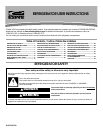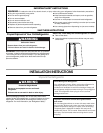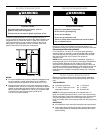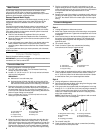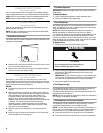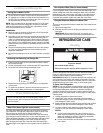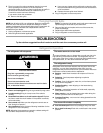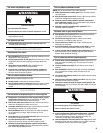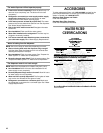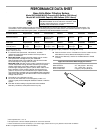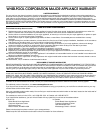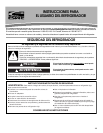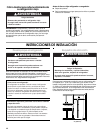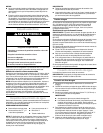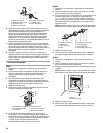
7
Ice Maker and Storage Bin
Turning the Ice Maker On/Off
■ To turn ON the ice maker, simply lower the wire shutoff arm.
■ To manually turn off the ice maker, lift the wire shutoff arm to
the OFF (arm up) position and listen for the click. Ice can still
be dispensed, but no more can be made.
NOTE: Your ice maker has an automatic shutoff. As ice is made,
the ice cubes will fill the ice storage bin, and the ice cubes will
raise the wire shutoff arm to the OFF (arm up) position. Do not
force the wire shutoff arm up or down.
REMEMBER:
■ Allow 24 hours to produce the first batch of ice. Discard the
first three batches of ice produced.
■ The quality of your ice will be only as good as the quality of the
water supplied to your ice maker. Avoid connecting the ice
maker to a softened water supply. Water softener chemicals
(such as salt) can damage parts of the ice maker and lead to
poor quality ice. If a softened water supply cannot be avoided,
make sure the water softener is operating properly and is well
maintained.
■ Do not use anything sharp to break up the ice in the storage
bin. This can cause damage to the ice container and the
dispenser mechanism.
■ Do not store anything on top of or in the ice maker or storage
bin.
Removing and Replacing Ice Storage Bin
1. Pull the covering panel up from the bottom and then slide it
back toward the rear.
2. Lift the wire shutoff arm so it clicks into the OFF (up) position.
3. Lift up the front of the storage bin and pull it out.
4. Replace the bin by pushing it in all the way or the dispenser
will not work.
5. To restart ice production, push the wire shutoff arm down to
the ON position. Make sure the door is closed tightly.
Water Filtration System
Water Filter Status Light (on some models)
The water filter status light will help you know when to change
your water filter. The light will change from green to yellow. This
tells you that it is almost time to change the filter. It is
recommended that you replace the water filter when the status
light changes to red OR water flow to your water dispenser or ice
maker decreases noticeably. The filter should be replaced at least
every 6 months depending on your water quality and usage.
After changing the water filter, reset the water filter status light.
The status light will change from red to green when the system is
reset.
Non-Indicator Water Filter (on some models)
If your refrigerator does not have the water filter status light, you
should change the water filter cartridge at least every 6 months
depending on your water quality and usage. If the water flow to
the water dispenser or ice maker decreases noticeably before
6 months have passed, replace the water filter more often.
Using the Dispenser Without the Water Filter
You can run the dispenser without a water filter. Your water will not
be filtered.
1. Remove the water filter.
2. Slide the cap off the end of the filter and replace the cap in the
base grille.
IMPORTANT: Do not discard the cap. It is part of your
refrigerator. Keep the cap to use with the replacement filter.
REFRIGERATOR CARE
Cleaning
Both the refrigerator and freezer sections defrost automatically.
However, clean both sections about once a month to avoid
buildup of odors. Wipe up spills immediately.
IMPORTANT: Because air circulates between both sections, any
odors formed in one section will transfer to the other. You must
thoroughly clean both sections to eliminate odors. To avoid odor
transfer and drying out of food, wrap or cover foods tightly.
To Clean Your Refrigerator:
NOTE: Do not use abrasive or harsh cleaners such as window
sprays, scouring cleansers, flammable fluids, cleaning waxes,
concentrated detergents, bleaches or cleansers containing
petroleum products on plastic parts, interior and door liners or
gaskets. Do not use paper towels, scouring pads, or other harsh
cleaning tools.
1. Unplug refrigerator or disconnect power.
2. Hand wash, rinse, and dry removable parts and interior
surfaces thoroughly. Use a clean sponge or soft cloth and a
mild detergent in warm water.
3. Wash stainless steel and painted metal exteriors with a clean
sponge or soft cloth and a mild detergent in warm water.
4. On some models, wash glass door panels with a clean
sponge or soft cloth and a mild detergent in warm water.
NOTES:
■ Do not hit the glass with pots, pans, furniture, toys, or
other objects. Scratching, hitting, jarring or stressing the
glass may weaken its structure, causing an increased
likelihood of breakage at a later date.
■ Do not close the doors until all shelves, drawers and bins
are in place.
Do not use with water that is microbiologically unsafe or of
unknown quality without adequate disinfection before or
after the system.
WARNING
Explosion Hazard
Use nonflammable cleaner.
Failure to do so can result in death, explosion, or fire.



